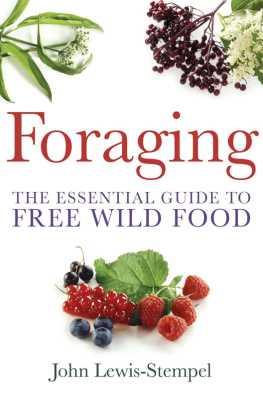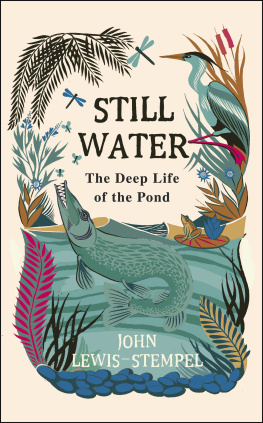John Lewis-Stempel made his first wildlife garden aged seven, after reading an article in the Young Ornithologists Clubs magazine. He has written on gardening and wildlife for numerous publications, including Landscape Design and Grow Your Own, has been a fulltime gardener, and worked for a conservation charity. In 2012 he received a Society of Authors Foundation Award for his writings on nature. As well as keeping a wildlife garden, he runs an organic farm. His other books include The Wild Life: A Year of Living on Wild Food and Foraging: The Essential Guide to Free Wild Food.
Other titles from Right Way and How To Books
FORAGING: THE ESSENTIAL GUIDE TO FREE WILD FOOD
John Lewis-Stempel
VEGETABLE, FRUIT AND HERB GROWING IN SMALL SPACES
John Harrison
VEGETABLE GROWING MONTH BY MONTH
John Harrison
THE WILDLIFE GARDEN
John Lewis-Stempel

Constable & Robinson Ltd
5556 Russell Square
London WC1B 4HP
www.constablerobinson.com
First published in the UK by How To Books,
an imprint of Constable & Robinson Ltd, 2014
Copyright John Lewis-Stempel 2014
The right of John Lewis-Stempel to be identified as the author of this work has been asserted by him in accordance with the Copyright, Designs & Patents Act 1988
All rights reserved. This book is sold subject to the condition that it shall not, by way of trade or otherwise, be lent, re-sold, hired out or otherwise circulated in any form of binding or cover other than that in which it is published and without a similar condition including this condition being imposed on the subsequent purchaser.
A copy of the British Library Cataloguing in Publication
Data is available from the British Library
ISBN 978-0-71602-349-4 (paperback)
ISBN 978-0-71602-355-5 (ebook)
Printed and bound in the UK
1 3 5 7 9 10 8 6 4 2
Cover copyright Simon Levy
Nobody made a greater mistake than he who did nothing because he could do only a little.
Edmund Burke
CONTENTS
ACKNOWLEDGEMENTS
The author and publisher wish to thank The Mammal Society for permission to reproduce the image of the small mammal footprint tube on .
PREFACE
Gardens are an increasingly important refuge for the nations wildlife. Often more friendly than farmland, they are now the main habitat for endangered species such as the song thrush and stag beetle. A typical garden can be home to twenty or more species of bird, five of mammal, several of amphibians and hundreds of invertebrates. A wildlife-friendly garden can easily, and unbelievably, be home to more than 5,000 species of fauna and flora. Per square metre, a wildlife-friendly garden is more biodiverse than the Amazon rainforest! This is because good gardens have an array of physical structures (from trees to fences), diverse micro-habitats, are constantly being remade by digging and contain an artificially high diversity of plants.
Making a garden wildlife friendly is doing your bit for Britains animals and plants. Domestic gardeners have a crucial role to play in the future of our wildlife; back gardens make up four per cent of Britains land surface, the same as Sites of Special Scientific Interest. It also helps make your garden fit for humans too. A wildlife garden is uplifting, a place of beauty, of inspiration and of pleasure, where all the senses are appealed to. A garden that is green and natural is proven to be better for your mental and physical health. A garden where a robin will perch on your hand to feed is a garden where children can properly appreciate the natural world.
Currently in vogue, wildlife gardening is actually a throwback to a pre-chemical, less formalistic gardening style. A traditional cottage garden was heaven on earth for butterflies and bees, and its not difficult to make. It really only requires you to give nature a helping hand. Neither is wildlife gardening an all or nothing creed. Wildlife gardening is not a religion, but a pragmatic solution for humans and nature to share the same space. With a little know-how and energy, any garden, no matter how small, can be a haven for wildlife. Many gardens, indeed, will only need tweaking to maximise their wildlife potential.
Your garden. Where the wild things can be.
CHAPTER 1
PLANNING THE WILDLIFE GARDEN
Wildlife and garden are often assumed to be opposites. After all, this way of thinking goes, wildlife likes long grass and informality, while gardeners like shaved lawns and order. Wildlife likes organic, gardeners like chemicals. Wildlife likes sprawling hawthorn hedges, gardeners like trimmed conifers.
And too many people assume that a wildlife garden is an area behind the house left to go native. This would not be a garden; this would be a scrubland wilderness. Funnily enough, it would not be as species-rich as even a moderately wildlife-friendly garden. A wildlife garden needs maintenance by people.
Other misconceptions abound: a wildlife garden does not have to be the size of Surrey to be effective. To a bee, a window box is a nectar hypermarket. Whatever the size of your garden, whether its a kitchen window in a flat or a sprawling, broad acre in the country, you can easily do something for wildlife. Everybody can help.
Planning a wildlife-friendly garden is not essentially different from planning any other form of garden. It is about what you want the garden to look like, what it needs to do a play area for the kids, a massive vegetable patch for self-sufficiency, a quiet retreat for creativity and working with the lie of the land. You also have to ask yourself a key question: how committed to wildlife are you? Do you want to do something for wildlife or everything for wildlife? How you answer the question is entirely up to you, but there are some simple rules every wildlife gardener should follow
THE TEN WILDLIFE GARDEN COMMANDMENTS
1. Plant plants, plants
Plants, plants, plants are the three most important words in wildlife gardening. Green as much of your garden as you are able to (not forgetting vertical spaces such as house walls and fences) with as great a diversity of plants as possible. Ideally you should choose native species, not least because this increases the native floral reservoir, but this is not a rule etched in stone. A hungry bird is as happy with firethorn berries as hawthorn berries. (That said, avoid modern, super-bred cultivars because few contain pollen or nectar.) Choose a range of plants to feed as many animals as possible over the course of the year.
2. Stop using chemicals
Pesticides can annihilate crucial layers of the food chain. There are other effective ways to keep pests and weeds under control. Learn to love bugs. Most are your friends.
3. Provide food and shelter for birds and beasties
To encourage birds into the garden, put up seed and peanut feeders and erect artificial shelters. Then grow natural food and cover. Other animals can also be fed, from hedgehogs to butterflies and bees. But always keep up feeding regimes. Make a wildlife hotel for creepy crawlies. Microfauna microscopic animals in the soil are interesting in their own right, often beneficial, and are a key stage in the garden food chain.
4. Give Tiddles a bell
The UKs cats kill 55 million birds a year. There is no evidence that cat predation is actually causing the decline in bird numbers, but with some garden species (notably the song thrush and tree sparrow) already under pressure it is prudent to give a cat a bell so potential feathered prey can hear it coming but the cats collar should be of a proper fit, and have a safety feature such as an elastic insert (stretch collar) so the cat can free itself if it becomes entangled.
Next page

















